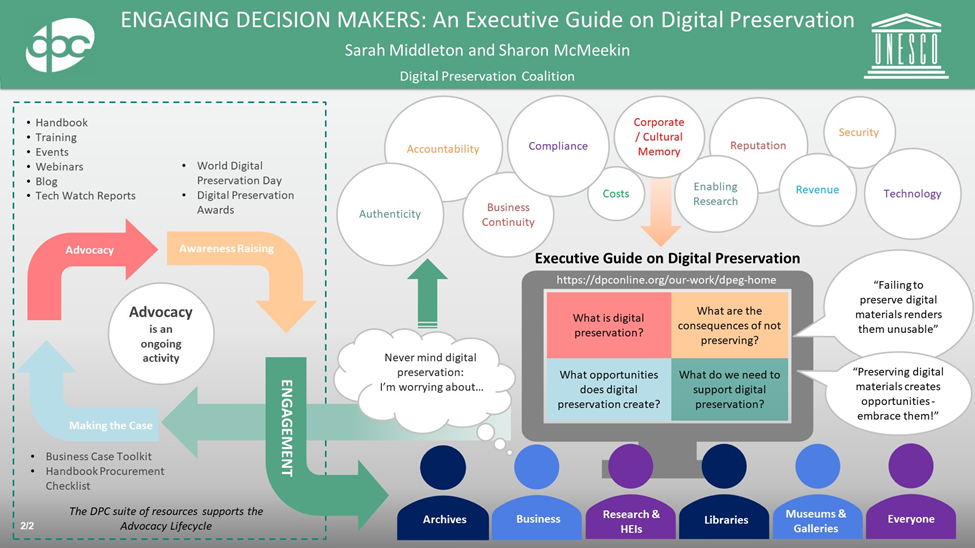Robert Buckley is the Chair of the PERSIST Policy Working Group and a Technical Adviser at the National Archives of the UAE.
UNESCO and the Digital Preservation Coalition (DPC) have collaborated to produce the Executive Guide on Digital Preservation, an online resource for raising awareness of the importance of digital preservation in archives, libraries and commercial enterprises—any organization that has digital assets to preserve and access. While many of us are often immersed in the technical aspects of digital preservation—in my case color image digitization and compression, it is generally realized that a successful and sustainable implementation of digital preservation requires support and commitment across an institution and beyond in the prevailing political, legislative and fiscal environment.

According to the DPC, digital preservation needs "...an enabling policy and regulatory environment including organizational and technical infrastructure which is appropriately resourced." And UNESCO, in its 2015 Recommendation concerning the preservation of, and access to, documentary heritage including in digital form, explicitly urges Member States “to consider their documentary heritage as an invaluable asset and to apply this perspective in national legislation, development policies and agendas.”
Evidently, there are conversations to be had between digital practitioners—those who plan, implement and manage digital preservation in an organization with digital assets to be preserved—and senior executives, policy- and decision-makers and legislators—those who enable the resources and shape the legislative, regulatory and policy environment which digital preservation needs to be successful.
This is where the Executive Guide on Digital Preservation comes in: to facilitate and motivate these conversations. It met the needs of the DPC to fill a gap in the advocacy lifecycle, helping members raise the topic of digital preservation at senior levels before attempting to make a formal business case for it (with the Digital Preservation Business Case Toolkit) and well before discussing good practices (using the Digital Preservation Handbook). Within the PERSIST project of the UNESCO Memory of the World Program, the Executive Guide met the needs of the Policy Working Group, one of whose deliverables was a Digital Preservation Starter’s Guide that would serve as an introduction for policy-makers.
If the Executive Guide on Digital Preservation were to be distilled down into one image, it would be this poster that Sarah Middleton and Sharon McMeekin presented at iPRES2019 and which won the Best Poster award there.

Advocacy and raising awareness in the box on the left fall within the scope of what DPC and UNESCO do. On the right are practitioners in organisations such as archives which have digital preservation within their mandate. They need to be able to communicate with senior managers, executives and policy-makers who can support digital preservation. Those responsible for policy, budgets and strategy are motivated by factors such as compliance, costs and security. They will want to know what digital preservation is, what are the opportunities and risk associated with it (or with not doing it) and what’s needed.
The Executive Guide on Digital Preservation provides practitioners with a combination of generic and specific messages and motivators designed to answer those questions. For example, in an archive, the failure to maintain a preservation system and processes can lead to the inability to access digital objects and the need to replace or extract data from outdated systems. These are consequences that are important to an organization motivated by costs and reputation. On the other hand, well-preserved digital materials enable an audit trail and contribute to accountability and compliance.
The Executive Guide recognises that every organisation is different, with different priorities, risk factors and motivators. So a user can select statements from the Guide and tailor them to their particular need and situation. Practitioners are welcome to submit the customised messages they create for inclusion in future versions of the Guide. For now, the Executive Guide is available only in English; translation into other languages is planned. If you have any questions or comments, feel free to contact DPC at info@dpconline.org or PERSIST at info@unescopersist.org.
